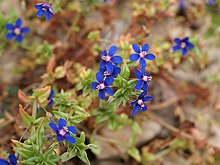Lysimachia foemina
| Lysimachia foemina | |
|---|---|
 |
|
| Lysimachia foemina | |
| Scientific classification | |
| Kingdom: | Plantae |
| (unranked): | Angiosperms |
| (unranked): | Eudicots |
| (unranked): | Asterids |
| Order: | Ericales |
| Family: | Primulaceae |
| Genus: | Lysimachia |
| Species: | L. foemina |
| Binomial name | |
|
Lysimachia foemina Mill. |
|
| Synonyms | |
|
|
Lysimachia foemina (commonly known as Poorman's Weatherglass and formerly known as Anagallis foemina) is a low-growing annual herbaceous plant of the genus Lysimachia belonging to the Primulaceae family. In a comparison of DNA sequences, L. foemina was shown to be most closely related to L. monelli. It had been thought by many to be closest to L. arvensis, and some authors had even included L. foemina as a subspecies of L. arvensis. The three species were among several transferred from Anagallis to Lysimachia in a 2009 paper.
The previous genus name Anagallis derives from the Greek words ana meaning "again" and agallein meaning "to delight in", possibly referring to the fact that these plants produce flowers twice in a year and the flowers open whenever the sun strikes them. The species epithet foemina means "female" and refers to the small size of the plant and the gentleness of its appearance. The common name refers to the fact that the flowers close at the approaching of the bad weather.
Lysimachia foemina has weak, square and sprawling stems growing to about 5–18 centimetres (2.0–7.1 in) long, which bear bright green sessile leaves in opposite pairs. The leaves are usually lance-shaped about 7–11 mm (0.28–0.43 in) wide and 12–16 mm (0.47–0.63 in) long, although some leaves, especially the lowest, may be ovate.
The small flowers are about 8 mm (0.31 in) in diameter, have a short stalk, are produced in the leaf axils and are usually blue. They have five lanceolate sepals and five petals. The filaments are about 3 mm (0.12 in) long, with showy yellow anthers. The flowering period extends from April to October. The hermaphroditic flowers are pollinated by insects (entomogamy). The fruit is a spherical capsule up to 4 mm (0.16 in) in diameter containing about 15 seeds.
...
Wikipedia
